 |
| Our first full day of touring in the Cairo area would begin with tours of Sakkarah and Memphis, which are both located a few miles outside of Cairo. Sakkarah is a very important ancient site in Egypt. The necropolis of Sakkarah was the largest in all of Egypt and of historical significance because all of the principal dynasties of Egypt are represented here. Its name was derived from the Egyptian god Sokar. | ||||||||||||||
| The most prominent ancient ruin at Sakkarah is the step pyramid of Zoser, the pharaoh who founded the IIIrd dynasty. Surrounding it are other pyramids and mastabas that are characteristic of the eras. Mastabas, the Arabic word for bench, were the burial chambers of the nobility and its court dignitaries. They were rectangular with slightly inclined walls. Zoser was the first pharaoh to envision a more grandiose burial complex. He commissioned the architect Imhotep to design and build his funerary complex. Imhotep's name can be found in the hieroglyphic characters on the base of a statue representing Zoser. Thus Zoser's was the first funerary structure to appear in the world. Imhotep was also a High Priest and doctor and a man of much genius. The Greeks, two thousand years later, named a god, Esculaphus, after him. Looking at the pyramid one can see what Imhotep did. He built a large rectangular mastaba and on it he placed five successively smaller mastabas to form the pyramid. |
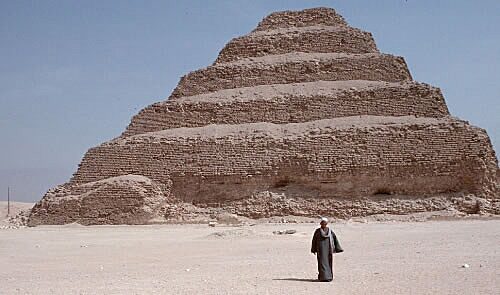 Zoser's Step Pyramid at Sakkarah |
|||||||||||||
| Surrounding Zoser's step pyramid
are a number of other funerary structures from different periods.
The pictures below show some of these structures as they exist in
the hot Sun at Sakkarah today. |
||||||||||||||
 |
<<< Zoser's step pyramid with other pyramids and funerary structures visible. To the south of Zoser's step pyramid lies the pyramid of Unas (small pyramid in background), the last pharaoh of the Vth dynasty. While it was already destroyed by 2000 B.C. the pyramid of Unas was important because it contained a large part of the pyramid text from the Old Kingdom. | |||||||||||||
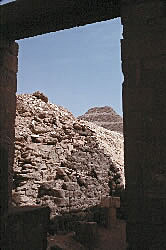 Zoser's Step Pyramid |
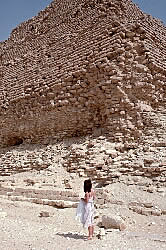 Anne standing by the loose bricks of Zoser's Step Pyramid |
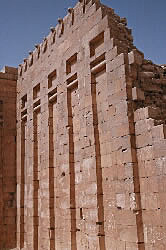 Side wall of the funerary complex at Zoser's Step Pyramid |
||||||||||||
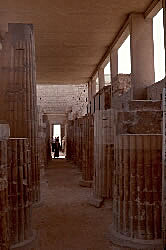 Inside the funerary complex at Zoser's Step Pyramid |
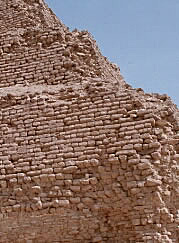 Close up of the loose stones on Zoser's Step Pyramid |
|||||||||||||
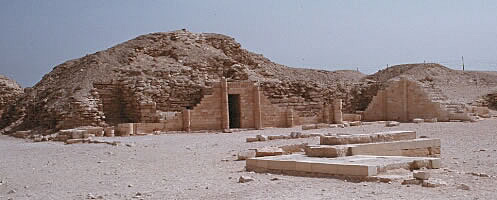 |
The photo at left is probably the remnants of the pyramid of Unas, a relatively small but important pyramid. As you can see by the doorway you can enter a number of the mortuary complexes at Sakkarah and within them view the ancient hieroglyphs that adorn the wall. Many exists today and show the same vibrant colors that they did when they were originally painted on the walls thousands of years ago. Here at Sakkarah we also viewed some of the oldest graffiti known to exists. A message that an Englishman left on the walls of one of the lesser tombs that dated to the early 1800's. | |||||||||||||
| Leaving Sakkarah we headed to Memphis the ancient capital of the first "nome" (province) of Lower Egypt. Join Anne and I there by pressing the next button. | ||||||||||||||